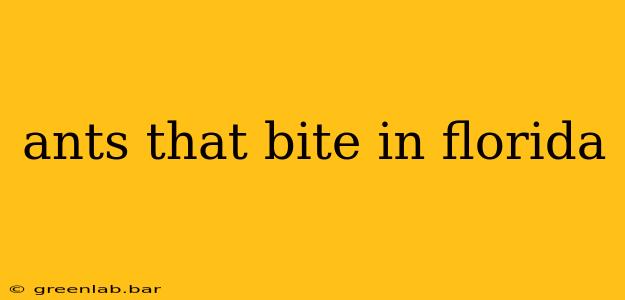Florida's warm climate provides a perfect habitat for a wide variety of ant species, some of which are notorious for their painful bites. Understanding which ants to watch out for is crucial for protecting yourself and your family. This comprehensive guide will delve into the most common biting ants found in the Sunshine State, detailing their identification, behavior, and what to do if you're bitten.
Identifying Florida's Biting Ants
Several ant species in Florida pack a potent sting or bite, ranging from mildly irritating to severely painful. Correct identification is key to appropriate treatment and prevention.
1. Fire Ants (Solenopsis invicta and Solenopsis saevissima):
- Identification: These are arguably Florida's most infamous biting ants. They are reddish-brown, with a relatively small size (1/8 to 1/4 inch long). Their mounds are easily identifiable, often lacking a central opening and appearing like small volcanoes of loose soil.
- Bite Characteristics: Their sting is intensely painful, causing immediate burning sensations, followed by a raised, pustule-like welt. Multiple stings can lead to severe allergic reactions in some individuals.
- Habitat: Fire ants thrive in open, sunny areas, often nesting in lawns, fields, and disturbed soil.
2. Carpenter Ants (Camponotus spp.):
- Identification: These larger ants (1/4 to 1/2 inch long) are typically black or dark brown, though some species exhibit reddish hues. Unlike termites, carpenter ants don't consume wood; they excavate it to create nests.
- Bite Characteristics: While their bite itself is not as potent as a fire ant sting, it can be painful and cause localized swelling. The real threat comes from potential secondary infections if the bite is scratched.
- Habitat: Carpenter ants are often found in damp, decaying wood, both inside and outside homes. They favor areas with moisture intrusion, such as leaky pipes or damaged roofing.
3. Acrobat Ants (Crematogaster spp.):
- Identification: Acrobat ants are relatively small (1/8 inch long) and have a distinctive heart-shaped abdomen that they raise upwards when threatened – hence the name. They are usually dark brown or black.
- Bite Characteristics: Their bite is described as a mild pinch, not typically causing significant pain or lasting reactions. However, they can be a nuisance due to their tendency to invade homes in large numbers.
- Habitat: These ants are common in both indoor and outdoor environments. They often nest in hollow spaces, such as trees, wall voids, and cracks in foundations.
4. Harvester Ants (Pogonomyrmex spp.):
- Identification: Harvester ants vary in color from reddish-brown to black. They are medium-sized ants (1/4 inch long) and known for their powerful jaws.
- Bite Characteristics: Their bite is painful, with a sharp pinching sensation and potential for localized swelling and itching.
- Habitat: These ants are usually found in dry, open areas, often creating large, prominent mounds.
What to Do if Bitten by an Ant in Florida
The best course of action depends on the type of ant and the severity of the reaction.
-
Immediate Actions:
- Clean the area: Wash the bite with soap and water.
- Apply ice: Reduce swelling and pain by applying a cold compress.
- Over-the-counter pain relief: Take ibuprofen or acetaminophen for pain relief.
- Antihistamine: If you experience itching, an oral antihistamine can help.
-
When to Seek Medical Attention:
- Severe allergic reaction: Symptoms such as difficulty breathing, swelling of the face or throat, dizziness, or hives require immediate medical attention.
- Persistent pain or swelling: If symptoms worsen or persist for more than a few days, consult a doctor.
- Infection: Signs of infection, such as increased pain, redness, pus, or fever, necessitate a doctor's visit.
Prevention Strategies
Preventing ant bites involves both eliminating attractants and preventing nest establishment.
- Proper sanitation: Keep food and drinks covered, clean up spills immediately, and store food in airtight containers.
- Eliminate moisture: Repair leaky pipes, address any water damage, and ensure good ventilation.
- Professional pest control: For severe infestations or persistent problems, contact a licensed pest control professional. They can identify the specific ant species and provide targeted treatment options.
This information is intended for educational purposes only. Always consult with a healthcare professional for any medical concerns. Understanding the biting ants of Florida and practicing preventative measures are crucial steps in enjoying the outdoors safely.

